What Inspires You?
In this feature, each month artists share one thing that excites them creatively.
One key piece to support healthy, productive creativity is stimulating inputs. What kinds of things stimulate the creative centers of the brain? What kind of inputs stimulate us visually? Emotionally? Spiritually? Mentally? Physically?
I’d really like to know, what’s one thing that fills your creative cup? Share with us in the comment section below.
Matthew Johnson
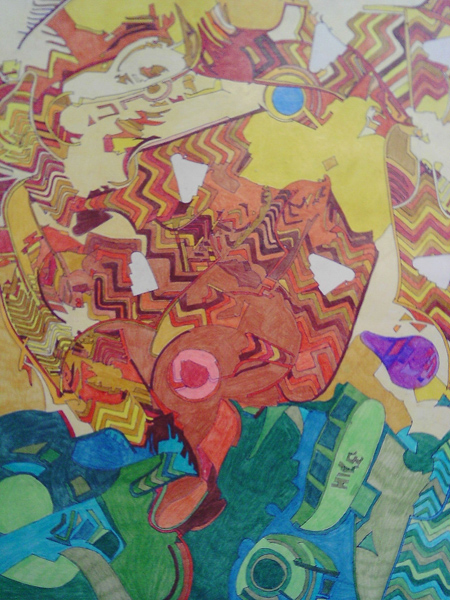
Hello M.A. bloggers, my name is Matthew Johnson and my creative stimulation dwells within the realm of the creation we call “Life.” From the tiniest insects that stroll around among the vast plains, and rolling hills of this planet, to the human machines that occupy this world, and discover the ins and outs about our existences through experiences. There are so many outlets that my artistic view drives upon, and my mind travels alongside imagination avenue with my solar-battery operated automobile packed full of music, paint, pens, and a broken navigational device (to ensure that I am in no way shape or form ‘set’ within any boundaries of expression). As you stroll through the corridors of the imagination, it is only you that can entail what you see and then begin to proceed to create the pieces you’re driven to produce. Continue all the great work, and may peace be your imagination’s significant other.
Matthew Johnson
Toni Murgas
 Things that inspire me may be a picture of nature, a book I’m reading, a dream or a song. I was reading a book on Edward Manet and how he used to cut paper as he got older to create his art. This inspired me to cut and paste colored paper.
Things that inspire me may be a picture of nature, a book I’m reading, a dream or a song. I was reading a book on Edward Manet and how he used to cut paper as he got older to create his art. This inspired me to cut and paste colored paper.
Toni Murgas
Leave a Comment
Nine Tips For Making Great Digital Images of Your Art
I’ve sat on a few art juries before in a darkened room for hours looking at hundreds of projected images. The consensus from numerous jurors is that although you create outstanding art, if your images don’t show it, you can forget about getting selected.
Sometimes an overly dark or blurry photograph of a painting or sculpture is projected on the screen and you wonder “How could someone put such exquisite care into their art and not have noticed how poor these digital images are?”
It can happen to the best of us. Unless you are a photographer already, you may not have the skills or the eye yet to even know when your images are representing your work well.
Here’s something I’ve noticed: I spend so many hours, days, months with each piece of art I make that I often can’t “see” what my digital images really look like. Because I have such a deep relationship with the work, I see it as I visualize it in my head not as it’s appearing on the screen.
I’ve had to really train my eye over the years to be discerning as to whether my pictures are really representing the work. And, yes, it’s taken years.
Some suggestions:
1. If possible, sit down at your computer with your original art piece in your line of vision. Glance back and forth at both and pay attention to details, light, texture, etc. Really scrutinize every aspect of your work. Do those digital pictures really look like your work?
2. Find a discerning friend (or two) to do the same exercise. First show them the images on your computer, then show them the actual artwork. Ask them to be very specific as to the differences they see.
3. Invest in (or borrow) a good quality digital camera (a digital SLR with a detachable lens) to document your work. If you don’t have the funds yet, start putting away a little money each month. This will give you time to do your research.
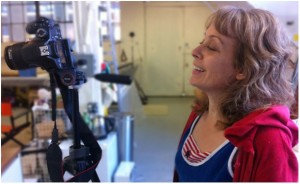
4. Research your camera options fully before buying. Use the internet, consumer reports, your camera geek friends, youtube reviews, etc. Some camera buffs LOVE to talk about cameras and will be happy to share their knowledge with you. They’ll also throw around a lot of technical jargon that may confuse you. Take notes. Give yourself time to learn and study. Don’t rush into your purchase.
5. Make a list of all the features you need your camera to have. If you make jewelry, you’ll need a different type of lens from an artist who does large scale public artworks.
6. Save money. When you are sure of what you want or need and have the choices narrowed to a few models, keep an eye out for sales or scan craigslist.
7. Learn a photo editing program such as Adobe Photoshop. If you take your own photographs, you must learn to use Photoshop®. There are some easy-to-learn tricks for making your work look better on the computer screen which is where most people will see it first. Even if you aren’t a great photographer, don’t have the best camera or have less-than-ideal lighting there are tons of things you can easily correct if you know Photoshop®. I recommend Photoshop because it’s the industry standard, and once you learn the basics, you can take it further if you like.
8. If you do small scale, 2-D work, try scanning it. I’ve saved a lot of money on professional photography by scanning my small works on paper. Important because when you do a lot of drawing, you can be quite prolific.
9. Hire a professional! If all this sounds totally daunting, and you are in a position financially to hire a professional art documenter to photograph your work, please DO! It is one of the BEST investments you can make in your work. Keep in mind that not any professional photographer can do good art documentation. Just as not every painter knows how to do monotype. Different skill sets, different equipment. Do your research. Ask artist friends for recommendations or call local museums and galleries and find out who they use. Be prepared to spend at least $125 an hour or a per artwork fee, plus processing. You may be able to save money here if you know Photoshop and can do your own image processing.
Leave a Comment
Worst Mistake Acrylic Painters Make
After one of my acrylics talks a few years ago, an artist pulled me aside and said,
“Now, I finally understand why my paintings are falling apart! I wish I had known what you just taught me 10 years ago!”
My heart went out to her. I’ve made more technical mistakes with my art over the years than I care to recount. That’s why I’m so passionate about sharing with artists how to build a sound and stable paint film.
I don’t want to hinder anyone’s creative process. That’s the last thing I want! That’s why I offer some sound alternatives here to get the same look without harming the paint film.
Please, please share this info with all your painter friends, artists groups, classes, professors, etc. I’ve found in the 15 years I’ve been teaching this to artists of all levels from those with 40 years experience and paintings in museums to the absolute beginner, only about 5% have ever heard of underbinding. Let’s make sure no more artists have their paintings fall apart by something that could easily be avoided.
These are the materials I mentioned in the video above:
Liquitex airbrush medium
Liquitex gloss medium
Liquitex acrylic gesso 32oz.
Leave a Comment
What Inspires You?
In this feature, each month artists share one thing that excites them creatively.
One key piece to support healthy, productive creativity is stimulating inputs. What kinds of things stimulate the creative centers of the brain? What kind of inputs stimulate us visually? Emotionally? Spiritually? Mentally? Physically?
I’d really like to know, what’s one thing that fills your creative cup? Share with us in the comment section below.
What Inspires You?
Dave Reid
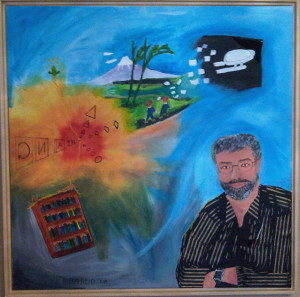 I’m inspired by science (nanotechnology, for example), colour, other cultures, history (West coast native art is great), form and sky. Often one thing will lead to another; I’m working on some pictures for an upcoming show – one picture took an abrupt turn, which I followed and am now learning new aspects from this.
I’m inspired by science (nanotechnology, for example), colour, other cultures, history (West coast native art is great), form and sky. Often one thing will lead to another; I’m working on some pictures for an upcoming show – one picture took an abrupt turn, which I followed and am now learning new aspects from this.
Dave Reid
What Inspires You?
Sean Glenn
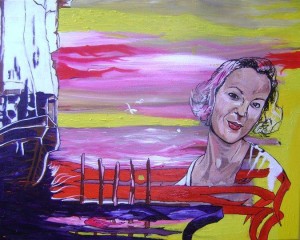 Life is what inspires me: the authenticity of each emotional experience lends validity to each brush stroke. What inspires is sometimes the pain that comes with living, it’s joys, it’s sorrows, it’s triumphs and it’s losses. What inspires me is love.
Life is what inspires me: the authenticity of each emotional experience lends validity to each brush stroke. What inspires is sometimes the pain that comes with living, it’s joys, it’s sorrows, it’s triumphs and it’s losses. What inspires me is love.
Sean Glenn
http://www.wix.com/
Leave a Comment
Saving Acrylic Paint on Your Palette
Isn’t it frustrating (and expensive!) to waste paint? I’ve got a video for you with my favorite tips on how to save acrylic paint on your palette after your painting session. Please feel free to post your comments or suggestions!
Metal butcher tray
Glad Press n’ Seal
Leave a Comment
What Inspires You?
In this feature, each month artists share one thing that excites them creatively.
One key piece to support healthy, productive creativity is stimulating inputs. What kinds of things stimulate the creative centers of the brain? What kind of inputs stimulate us visually? Emotionally? Spiritually? Mentally? Physically?
I’d really like to know, what’s one thing that fills your creative cup? Share with us in the comment section below.
What Inspires You?
Linda Ursin
What inspires me?
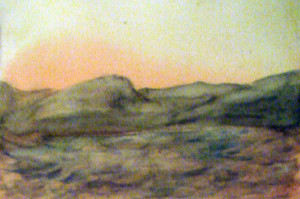 Anything and everything. It’s hard for me to pick one. I can’t really say I know where it comes from. I’m multi-creative, which means I create in many different ways.
Anything and everything. It’s hard for me to pick one. I can’t really say I know where it comes from. I’m multi-creative, which means I create in many different ways.
Linda Ursin
Website: heksebua.com/linda
What Inspires You?
Leo Anderson
What inspires me?
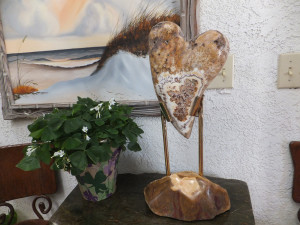 Ideas come from everywhere. God gave us a lot to work with and putting it together in a unique way intrigues us all. Make notes. Your mind is full and universal mind has all – so take notes on what comes to you. It doesn’t matter if you’re working on a thing or not. Put a date on it. Do everything you do perfect because it’s all only single steps. Nature is full, observe!
Ideas come from everywhere. God gave us a lot to work with and putting it together in a unique way intrigues us all. Make notes. Your mind is full and universal mind has all – so take notes on what comes to you. It doesn’t matter if you’re working on a thing or not. Put a date on it. Do everything you do perfect because it’s all only single steps. Nature is full, observe!Leo
Leave a Comment
